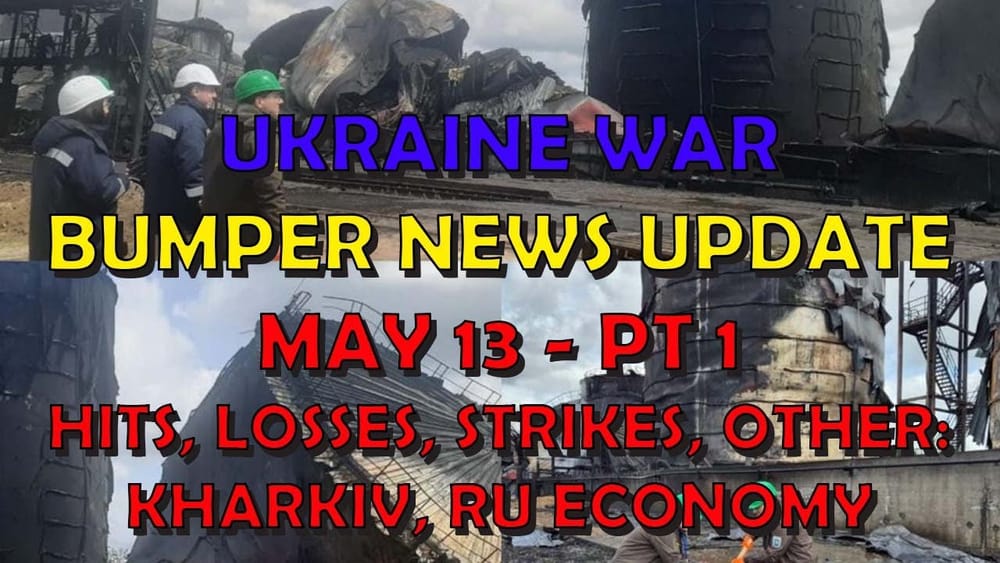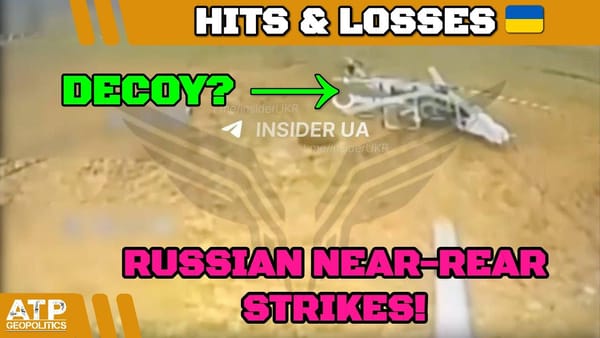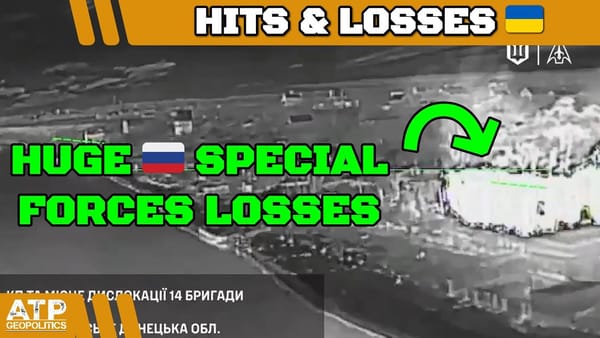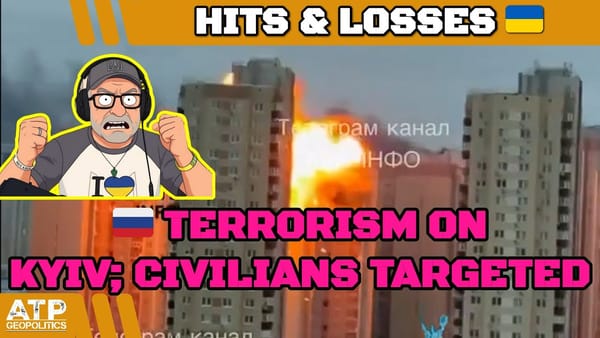Ukraine War Update NEWS: Pt 1 - Overnight & Other News
Table of Contents 📖
"Russia would never never do it [increase taxes on Gazprom] just doesn't make any sense unless Russia is desperate for money. Russia needs that money to keep prosecuting the war. And so it says, I'm sorry, mate. I know you made losses next year, but we need more money out of you. We're going to tax you even more."
Hello Team
🎦 00:00-00:37⏩
Jonathan welcomes everyone to the channel for another Ukraine War Update. He explains he had to re-record the video due to audio issues. Jonathan mentions he was on Tochny's live stream the previous evening and had a great time.
Return to top⤴️
🪦 DISCLAIMER FOR GENERAL STAFF LOSSES DATA
- These are real people with real lives and real families who love them. Don’t let the numbers sap your humanity.
- These numbers probably aren’t accurate but they’re the best we have and we don’t need them to be accurate to be indicative of patterns of activity.
- All losses are estimates. Losses cannot be counted with accuracy because of the conditions on the ground.
- Both sides would see it to be of their advantage to minimize their own losses maximize the other side’s losses.
- Neither side releases their losses but we have enough transparency from the Ukrainian side to have confidence in they are indicative.
- Personnel losses are hard to count. If a soldier gets injured, heals up, and returns to the front line only to get injured again, is that one loss or two? Also, how to deal with losses from PMC’s or soldiers fighting with RF from occupied territories?
- Equipment losses are hard to count. If an AA complex involves several parts and one part gets disabled, is that a loss, or a fraction of a loss? If a tank gets disabled, repaired, back into the fight, then disabled again, is that one lost tank or two?
- All recorded losses are vulnerable to multiple reporting. We have already seen numerous cases of multiple drones in the air reporting the same loss from different angles as multiple engagements.
- Losses are not always reported on the same day they occurred. It is frequent that drone losses are reported at least 24 hours after other terrestrial equipment losses. Certain losses may not be reported for days or weeks for military intelligence reasons.
Record Russian Losses
🎦 00:37-03:23⏩
Jonathan highlights that the volume of equipment and personnel losses being inflicted on Russian forces is unsustainable with the Ukrainian General Staff reporting record numbers:
- 1,740 personnel
- 31 tanks
- 42 armoured personnel vehicles
- 15 artillery systems
- 7 multiple launch rocket systems
- 59 vehicles and fuel tanks
- 6 pieces of special equipment
He notes that even if these figures are overestimated by 30% (which he doubts), the volume of losses remain unsustainable. Jonathan questions the wisdom of Russia's offensive in Kharkiv Oblast, suggesting their losses may not be justified based on their objectives which he believes are likely to secure a buffer zone to protect Belgorod from Ukrainian artillery strikes.
Return to top⤴️
HIMARS Strike on Donetsk Restaurant
🎦 03:50-04:39⏩
Jonathan discusses the HIMARS strike on the Paradise Restaurant in Donetsk city on 11th May 2023 which killed four officers and two Spetsnaz servicemen who were celebrating the 10th anniversary of the referendum on the creation of the self-proclaimed Donetsk and Luhansk People's Republics. He believes Russia will be investigating how intelligence about the gathering was leaked and questions whether it was worthwhile holding such an event given the risks.
Return to top⤴️
Russian BTR Hit by a Mine - Evidence of Equipment Shortages?
🎦 04:39-06:39⏩
Jonathan analyses footage shared by Andrew Perpetua of a Russian BTR (armoured personnel carrier) driving over a mine. Although the BTR withstands the explosion and no casualties are sustained, he is struck by the number of Russian soldiers who emerge from the vehicle - at least 20. He observes that typically, the Russians would have deployed a dozen vehicles for this type of attack, with fewer personnel per vehicle. Jonathan believes this highlights chronic equipment shortages faced by the Russian army, forcing them to cram their soldiers into fewer vehicles.
Return to top⤴️
Increase in Footage of Russian Casualties
🎦 06:47-07:52⏩
Jonathan highlights the surge in footage emerging from the front lines depicting heavy Russian casualties inflicted by Ukrainian drone strikes. He shares a comment from a viewer "Jane Keeve": "The amount of videos I'm seeing of Russian troops getting slaughtered is at an all-time high. It's just crazy right now". Jonathan reflects on the moral implications of drone warfare, acknowledging that the footage is difficult to watch, but these are the realities of war and these soldiers are invaders.
Return to top⤴️
Wildfires Engulfing Luhansk Forests
🎦 08:01-08:35⏩
Jonathan draws attention to satellite imagery from NASA showing wildfires raging near the front lines in Luhansk, close to the Serebianski Forest. He explains that with rising temperatures and dry vegetation, the risk of wildfires is increasing, and in a warzone, there's little chance of containing them. Jonathan expresses sadness that nature is another casualty of the war.
Return to top⤴️
Ukrainian "Wild Weasel" Missions to Suppress Russian Air Defences
🎦 08:35-14:45⏩
Jonathan discusses an article in Business Insider about Ukraine's use of "Wild Weasel" missions to target Russian air defences. He explains that these missions typically involve baiting Russian radar systems into activating, allowing Ukrainian forces to identify and destroy them, often using HARM (High-speed Anti-Radiation Missiles) . He highlights comments from defence analysts who note that Ukrainian pilots are now adapting their tactics in response to Russia's adaptation to these missions:
- Initially, Ukraine used HARM missiles to destroy Russian radar systems directly.
- Russian forces adapted by powering down and relocating their radar systems when HARMs were detected.
- Ukrainian pilots have adapted by using HARMs and decoys as a means of suppression, rather than destruction, creating opportunities for Ukrainian artillery (e.g. HIMARS) and aircraft to strike Russian targets during these brief windows of radar inactivity.
Jonathan explains that Ukrainian MiG-29 and Su-27 fighter jets have been modified using iPads to enable them to carry and deploy Western weaponry.
Return to top⤴️
Drone Strikes on Russian Territory
🎦 14:45-15:33⏩
Jonathan reports that Russia has experienced a wave of drone strikes, with explosions reported in the following regions:
- Lipetsk (electrical substation on fire)
- Kursk
- Belgorod
- Occupied Crimea
Jonathan notes that whilst Russian authorities claim to have shot down 31 drones, damage to infrastructure is inevitable and the true extent of the damage will likely emerge later. He also mentions Ukraine's deployment of the "Ninja" drone, capable of striking targets 1,500 km away and the Luchi drone which has been used in 80% of attacks on Russian oil refineries.
Return to top⤴️
Russian Missile Attacks on Odessa
🎦 15:33-19:05⏩
Jonathan expresses concern about Russia's relentless missile attacks on Odessa, highlighting the long-term damage to agricultural infrastructure, including the recent attack on a Singaporean agro-industrial enterprise which resulted in $1.5m of damage, 10 storage tanks destroyed, the loss of 10,000 tonnes of vegetable oil, and widespread land contamination. Jonathan questions the legality of Russia's actions, particularly the targeting of infrastructure owned by third-party nations, and wonders whether there will be repercussions. He also draws a comparison to the damage sustained by Russian oil refineries, pointing out that whilst the physical damage may be comparable, Russia's access to spare parts and expertise is hampered by international sanctions.
Return to top⤴️
Ukrainian Grain Exports Exceed Pre-Invasion Levels
🎦 19:43-21:52⏩
Despite Russian attacks on Odessa, Jonathan shares a more positive report from UK Defence Secretary Grant Shapps, who has highlighted that Ukrainian grain exports have now surpassed pre-invasion levels. A graph shows that, following a steep decline in exports in the aftermath of the invasion (and the collapse of the Black Sea Grain deal), Ukraine has successfully established an export corridor through the Black Sea in conjunction with its international allies, enabling it to export more grain than at any point since the war began. Jonathan describes this as "really, really good news".
Return to top⤴️
Decline in the Effectiveness of Ukrainian Air Defences
🎦 21:52-22:52⏩
Despite the good news about grain exports, Jonathan shares an article from the Wall Street Journal reporting that Ukraine is shooting down a smaller proportion of Russian missiles than earlier in the war.
- Over the past 6 months, Ukraine has intercepted 46% of Russian missiles, down from 73% in the previous 6 months.
Jonathan offers two possible explanations:
- Ukraine is running low on ammunition for its Western-supplied air defence systems, such as Patriots.
- Russia is adapting its tactics, possibly by using more Iskander-M and Kinzhal ballistic missiles, which are much harder to intercept. Jonathan believes that both factors are likely contributors.
Update on the Kharkiv Offensive
🎦 22:52-29:54⏩
Jonathan analyses the latest developments in the Kharkiv offensive, referring to maps and drawing attention to areas where the Russian advance appears to have slowed considerably in recent days. He addresses criticisms circulating online suggesting that Ukrainian defences in the region have been inadequate:
- Some commentators have expressed surprise at the lack of Ukrainian fortifications in the area.
- Jonathan argues that it would have been impossible for Ukraine to construct effective fortifications within 5km of the border due to the constant threat of Russian artillery, drones and mortar fire.
- He highlights that Ukrainian forces have been stockpiling artillery ammunition in preparation for the counteroffensive and could not, therefore, expend limited resources on disrupting Russian fortifications in the south.
He refers to a statement issued by the Commander of the 125th Separate Ground Defence Brigade of the Armed Forces of Ukraine, which refutes claims that the region was ill-prepared or that Ukrainian units had retreated:
- "Information about the unpreparedness of the defense forces for an enemy attack, or even worse, about the retreat of individual units from the defensive line entrusted to them is a frank lie. The settlements entered by the enemy were a permanent "gray zone", and therefore the enemy's success is quite conditional and cost them huge losses in equipment and manpower".
Jonathan highlights the significance of this statement, noting that it's rare for a military commander to speak so frankly, but it appears to be backed up by evidence. He shares insights from Ukrainian journalist Yuri Butasov (who is known to be critical of Ukraine) and military analyst Rob Lee, both of whom suggest that Ukrainian defences in Kharkiv are now solidifying, inflicting heavier losses on the Russians and slowing their advance. Jonathan acknowledges that there have been challenges, including the replacement of the commander of the OTU (Operational Tactical Group) in Kharkiv, but the situation appears to be improving. He cites the Institute for the Study of War's (ISW) assessment that Ukrainian forces are being hampered by restrictions imposed by its Western allies on the use of Western-supplied weapons for strikes on Russian territory, forcing Ukraine to engage with Russian forces piecemeal within Ukraine rather than targeting their تجمع points across the border.
Russian Cabinet Reshuffle - A Sign of Weakness?
🎦 29:54-34:10⏩
Jonathan analyses the recent cabinet reshuffle in Russia.
- Sergei Shoigu has been moved from his post as Defence Minister to become Secretary of the Security Council of Russia.
- Dmitry Patrushev, Putin's close ally and former head of the Security Council, has been sidelined.
- Dmitry Peskov, Putin's spokesperson, has been appointed as Defence Minister.
Jonathan is sceptical of claims that this represents a promotion for Shoigu, noting that Putin rarely rewards failure. He speculates that Patrushev's removal and Shoigu's sideways move are indicative of serious issues within the Russian government, possibly relating to the conduct of the war in Ukraine. Jonathan suspects that the appointment of Peskov to the role of Defence Minister is an attempt by Putin to assert greater control over the military-industrial complex and integrate it more fully into the Russian economy as the costs of war mount.
Return to top⤴️
Nationalisation of Russian Businesses
🎦 34:20-40:18⏩
Jonathan discusses an article published by Dutch outlet "NL Times" which reports that Russia is increasing taxes on its struggling energy giant Gazprom, despite the company suffering record losses. Jonathan argues that this decision highlights the increasingly desperate state of the Russian economy and suggests that this is just one example of a wider trend. He points out that Russia would never ordinarily increase taxes on one of its key industries during a time of economic hardship unless it was desperate for money to fund the war in Ukraine. He goes on to highlight the nationalisation of dozens of private businesses owned by oligarchs since the start of the war in an attempt to seize assets and control sources of revenue. Jonathan provides several examples:
- In March, Russian prosecutors announced lawsuits against two major Russian companies: Makfa JSC (pasta producer) and Ariant (winemaker)
- Oligarch, Andrey Antipov's assets have been seized by the Russian state.
Jonathan explains that Transparency International Russia estimates that at least 40 businesses have been forcibly nationalised since the war began, representing an estimated €10 billion in assets. He believes this strategy is motivated by two key factors:
- To neutralise potential sources of dissent or opposition to the war.
- To shore up the Russian economy and fund the war effort.
Jonathan concludes that these actions suggest that Russia is in a precarious position, both economically and politically, which is ultimately good news for Ukraine.
Return to top⤴️
Examples of Russian Losses
🎦 40:18-42:51⏩
Jonathan shares further examples of the devastating losses being inflicted on Russian forces, highlighting the human cost:
- He describes harrowing footage from Getty Images in which a drone targets a building in which 20 Russian soldiers are sheltering, resulting in a catastrophic explosion that completely destroys the building, likely killing or injuring everyone inside.
- Jonathan highlights footage of a Russian attack on Ukrainian positions near Torska which resulted in 5 Russian tanks and 5 BMPs (infantry fighting vehicles) destroyed or disabled.
Jonathan uses these examples to illustrate that the casualty figures being reported by the Ukrainian General Staff are credible, particularly given the volume of video footage emerging from the front lines.
Return to top⤴️
Wrap up
🎦 42:51-43:00⏩
Jonathan thanks everyone for watching and signs off.
Return to top⤴️



